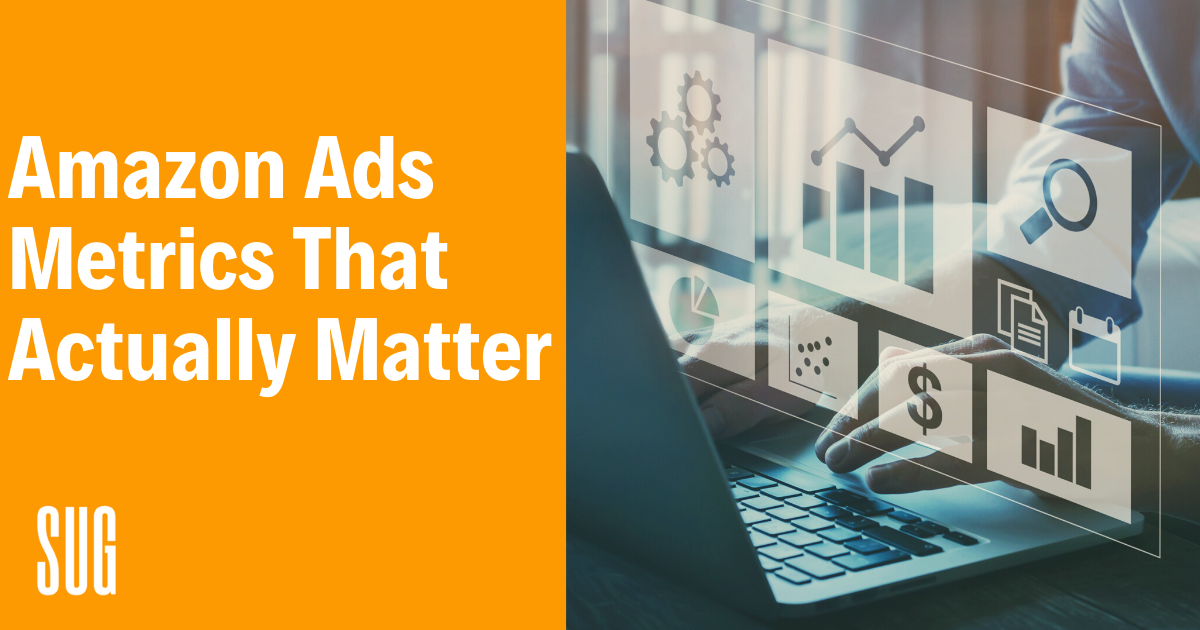Amazon Ad Metrics That Actually Matter
 Thanks to Amazon’s advertising reports in seller central and advertising console, Amazon sellers get tons of data on how their listings are performing.
Thanks to Amazon’s advertising reports in seller central and advertising console, Amazon sellers get tons of data on how their listings are performing. These brand metrics can become overwhelming, there’s no clear definition of what a ‘good’ metric goal should be.
In this article, we’ll break down these metrics and help you understand which metrics to focus on, based on your growth and overall goals.
How Do I Know If I Have Good Metrics?
There is no one ‘good’ metric or number to hit for each of these metrics.All of your goals and target metrics should be based on your growth goals.
For example, a net new brand on Amazon would likely have a lower conversion rate, but would be looking for a higher clickthrough rate, to increase brand awareness and eyes on your listings.
Let’s dive deeper into a SUG case study to understand.
A SUG Case Study - Amazon Metrics + Goals
A large protein brand was down $4M on their sales target with 5-6% ROAS on a 5 figure monthly ad spend. They thought they were crushing it – a 5-6% ROAS is usually great!Although their profitability per dollar was high – their AOV was around $20 with a $4 CPC, and they were not showing up on the front page of any of their search terms.
Our solution – an emphasis on unbranded search terms. Over 80% of their ads were on branded search terms, meaning these customers were already looking for their product. We converted that spend to unbranded search to introduce their product to new customers.
We were able to make up their $4M in revenue in three months and we increased their total annual sales by $25M (200%) !
We can help you understand your growth goals and target metrics at Straight Up Growth!
Types of Ads
At Straight Up Growth, we run our ads on a cost-per-click, or CPC basis. The other option is through Amazon DSP, which runs on a CPM, or cost per thousand.
We prefer CPC, as you’re only paying for direct clicks, and you don’t have to pay for impressions.
In this article, we’ll go into detail about CPC metrics.
Conversion rate (CVR)
Your conversion rate is the number of people who convert from viewing one of your ads to actually making a purchase. This is calculated by the number of units divided by overall clicks. These are clicks from any of your advertisements, including sponsored brand and sponsored product ads.At Straight Up Growth, we call this the ‘king metric’, because this helps understand your search term relevance. This helps you understand which search terms you’re relevant under, and this greatly helps in improving your relevancy score, and improving your organic relevance.
If you have a lower conversion rate, we would recommend improving your keywords and listing!
A big part of the conversion rate that many Amazon Sellers miss is the ad attribution window. This is a 14 day window of opportunity for someone to make a purchase of an item they saw from one of your advertisements. If someone sees an ad and decides to buy the item a few days later, it will still count towards your overall conversion rate.
Keeping this in mind is key, especially for higher priced items with a longer purchasing decision cycle!
Conversion rates are also key for new brands on Amazon. This will be more useful to understand your overall growth and performance compared to other metrics, which focus on profitability.
Click-Through Rate (CTR)
Your Click Through Rate is determined by the number of clicks your ad gets divided by the total number of impressions. Although, your Clickthrough rate does not have any impact on your relevancy score.The average CTR on Amazon Ads is about .41%.
Clickthrough rate and ad impressions go hand in hand. It’s useful to look at your impressions metrics to understand if your bids are high enough to be getting clicks. Once your impressions go up, your clickthrough rate should improve as well.
This is a more useful ad metric for DSP!
Return on Ad Spend (RoAS)
Return on Ad Spend (ROAS) is your sales divided by your ad spend. This is one of the most popular metrics to understand your profitability. ROAS and ACOS are inversely related.If your focus is on profitability, base your ROAS goal on your Average Order Value (AOV) and Cost Per Click (CPC).
Total Advertising Cost of Sales (TACoS) + Advertising Cost Over Spend (ACoS)
TACOS is your Total Ad Cost Over Spend. This is calculated by your entire ad spend, divided by your total sales.ACOS means advertising cost over spend. This is calculated by your ad spend divided by your ads driven sales.
What’s the difference between TACoS vs ACoS?
The only difference between TACos and ACoS is that ACos focuses on ads driven sales, while TACos looks at overall sales.
TACoS is so important, especially on Amazon, because Amazon ads will impact your overall visibility and sales. If you only focus on overall profitability, you may be missing out on some unbranded search terms that can convert at a higher rate!
Looking at your search term report may help you understand where to spend on specific keywords, which can help improve your ACos and TACoS. Over time, you may be able to ‘own’ a specific keyword, as your products will come up first under the sponsored product ads and organic rankings.
How ads metrics can help measure your campaign effectiveness
Based on your goals, focusing on a few ad metrics can help measure your campaign effectiveness.We would recommend only focusing on a few metrics per advertising campaign, to have clear goals and lower your overall ad spend.
For a campaign focused on brand awareness, your focus should be on clickthrough rate and impressions.
Later down the line, when you’re more focused on profitability or dominating a specific search result, the focus should be on improving your TACoS, depending on your average order value and cost per click.




